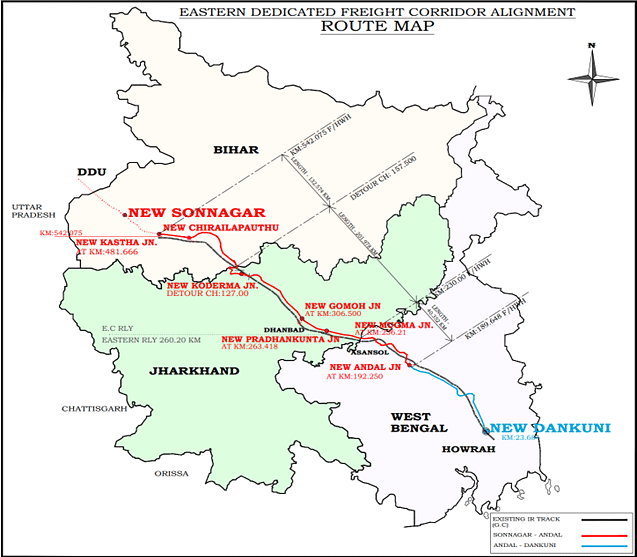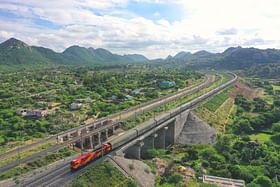The Ministry of Railways may have to abandon its search for a private agency under the struggling public-private partnership (PPP) model and move forward with funding a critical Rs 12,000-crore section of the Eastern Dedicated Freight Corridor (EDFC) on its own.
As per the Business standard report, “A proposal was moved to the Railway Board to construct the 371-km stretch between Sonnagar and New Andal through a railway organisation itself,” a senior executive of Dedicated Freight Corridor Corporation (DFCC) said.
“The project cost is close to Rs 12,000 crore now and we await approval to begin work on our own as in the rest of the corridors,” the executive quoted above said.
Following earlier reports, the government had decided to take up the development of the Sonnagar (Bihar) and New Andal (West Bengal) stretch of Eastern Dedicated Freight Corridor (EDFC) in the first phase rather than laying the rail corridor up to Dankuni as about 95 per cent of land available with them to be bid out quickly.
The PPP Model For The Eastern Freight Corridor
The Eastern Dedicated Freight Corridor (EDFC) spans 1,337 km from Sahnewal near Ludhiana in Punjab, crossing through Haryana, Uttar Pradesh, and terminating at Sonnagar in Bihar.
As part of this freight corridor, the overall 538 km stretch between Sonnagar in Bihar and Dankuni in West Bengal was proposed to be executed under the public-private partnership (PPP) mode since the beginning.

The Union Budget for 2021-22 also highlighted the government’s PPP ambitions for the freight corridor.
This stretch was intended to be the apex of the railway’s monetisation efforts, providing private sector players access to the corridor’s traffic.
For the 371 km stretch between Sonnagar (Bihar) and Andal (West Bengal) — proposed to be the first PPP project — the Dedicated Freight Corridor Corporation of India (DFCCIL) had reworked the proposal to attract bidders for the Rs 12,000-crore project and de-risk the private concessionaire.
The project was revised to be developed via a design, finance, build, operate and maintain and transfer (DFBOT) model.
The Director (operations and business development) of DFCCIL, stated, “We have proposed to put 25 per cent of the project cost during the construction period. The 95 per cent land will be provided during the first year of construction and the rest will be handed over the next year. We will be responsible for utility shifting”.
The private player will be responsible for design, finance (for 75 per cent of project cost), build, operation and maintenance for the contract period and then will transfer the project to the DFCCIL.
According to the BS report, “The hybrid DBFOT was a project-specific model designed for this stretch. The plan was to bring in a private player to build and maintain the infrastructure — to isolate the concessionaire from freight traffic volatility, the provision of availability charge was made,” said a senior railway official who was among the architects of that PPP model.
However, after several years of failed deliberations, the ministry is now inclined to taking up 75 per cent of the project in engineering procurement and construction (EPC) mode.
“We were hoping to look for a private player under this revised framework. However, after months, the hybrid DBFOT is yet to be approved by the Union Cabinet. It is a crucial stretch with multiple nodes stretching out to essential commodities like coal and steel. Internally, we want to ensure its completion quickly and the PPP plan may go against that,” a senior railway ministry official said, adding, due approvals, including from the Cabinet, would be required before proceeding with the plan.
Tracking The Overall Freight Corridor Progress
The DFC is the exclusive corridor for transportation of goods, and once constructed will decongest the railways’ network by moving 70 per cent of goods trains to these two corridors.
As per a Swarajya report, as much as 60 per cent of the dedicated freight corridors have been commissioned as on 31 January 2023, according to the latest progress report on the crucial railway lines.
The two Dedicated Freight Corridors (DFC) — namely Eastern and Western Dedicated Freight Corridors (EDFC and WDFC) aims to facilitate faster movement of freight traffic.
In addition to the EDFC, the 1,506-km-long WDFC runs from Dadri in Uttar Pradesh to Jawaharlal Nehru Port Terminal in Maharashtra.
A total route length of 1,724 km (861 km of EDFC and 863 km of WDFC) has been commissioned out of total 2,843 km till 31 January 2023.

The project, considered as India’s most extensive railway infrastructure development, has been under construction since 2006.
The completion of these corridors will allow the railways to enhance its customer focus and respond to market demands more efficiently.
The creation of such an expansive dedicated railway infrastructure is also anticipated to encourage the development of industrial corridors and logistics parks along its route.


